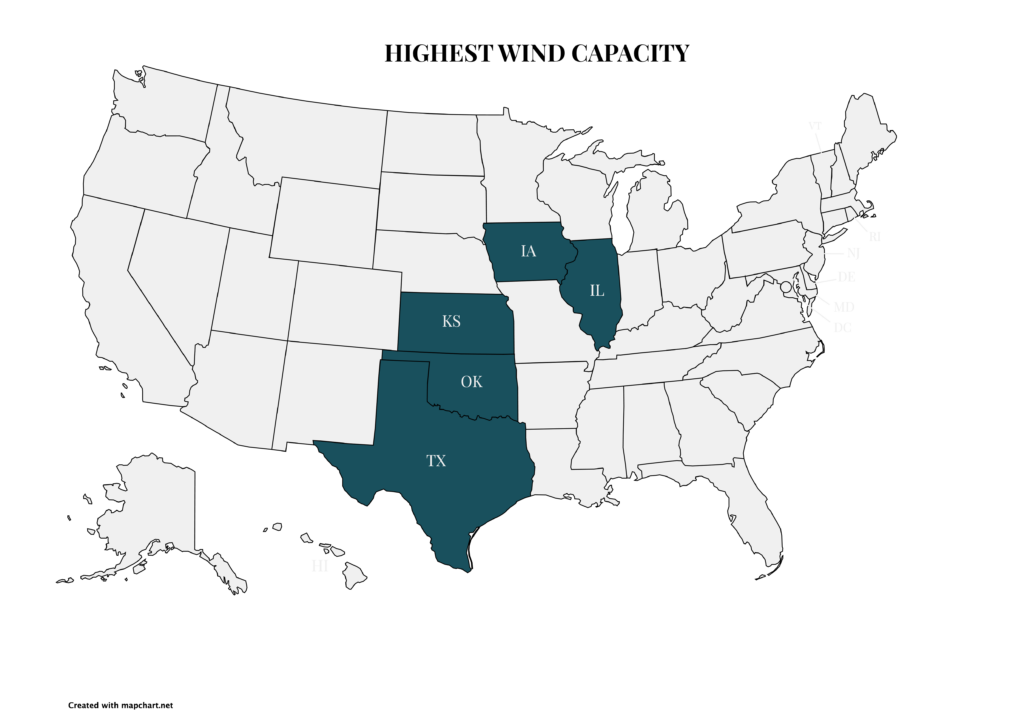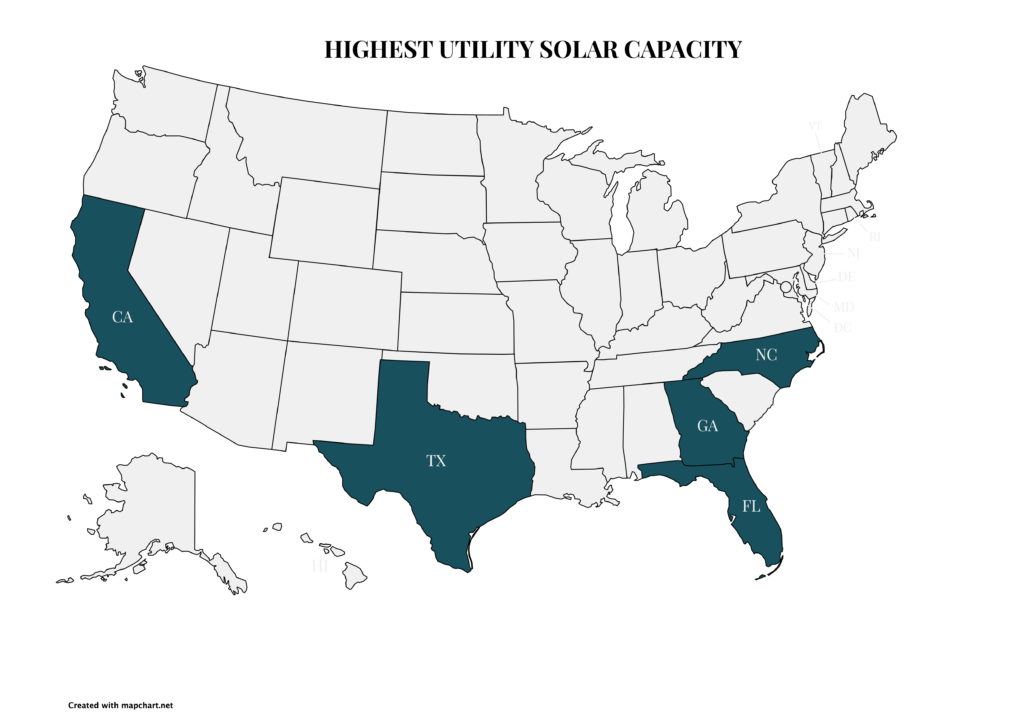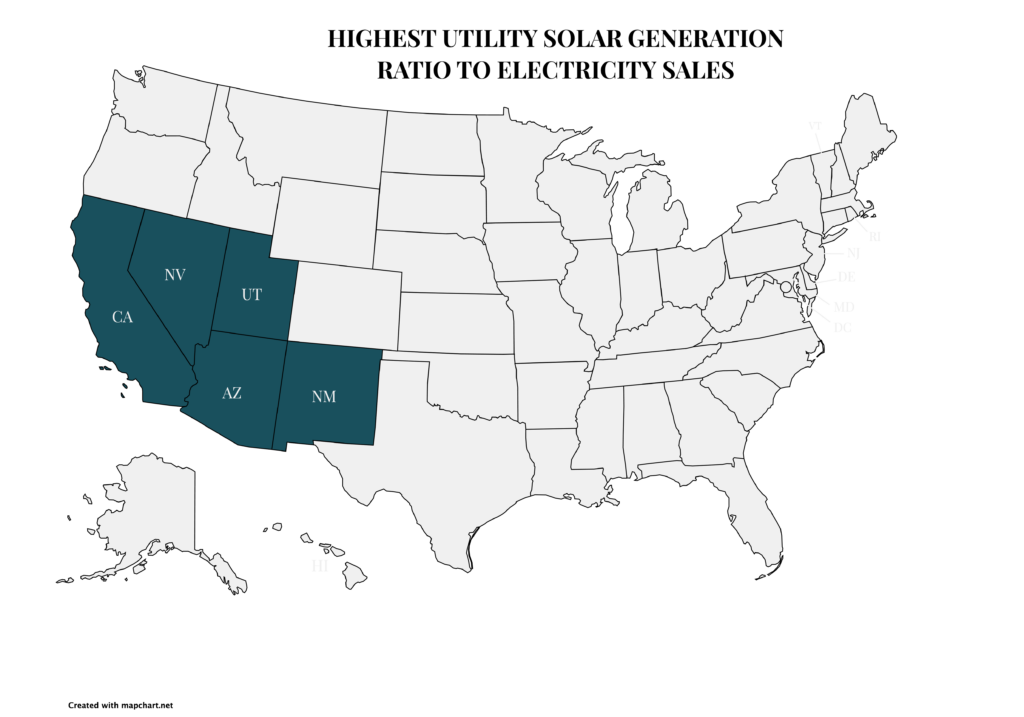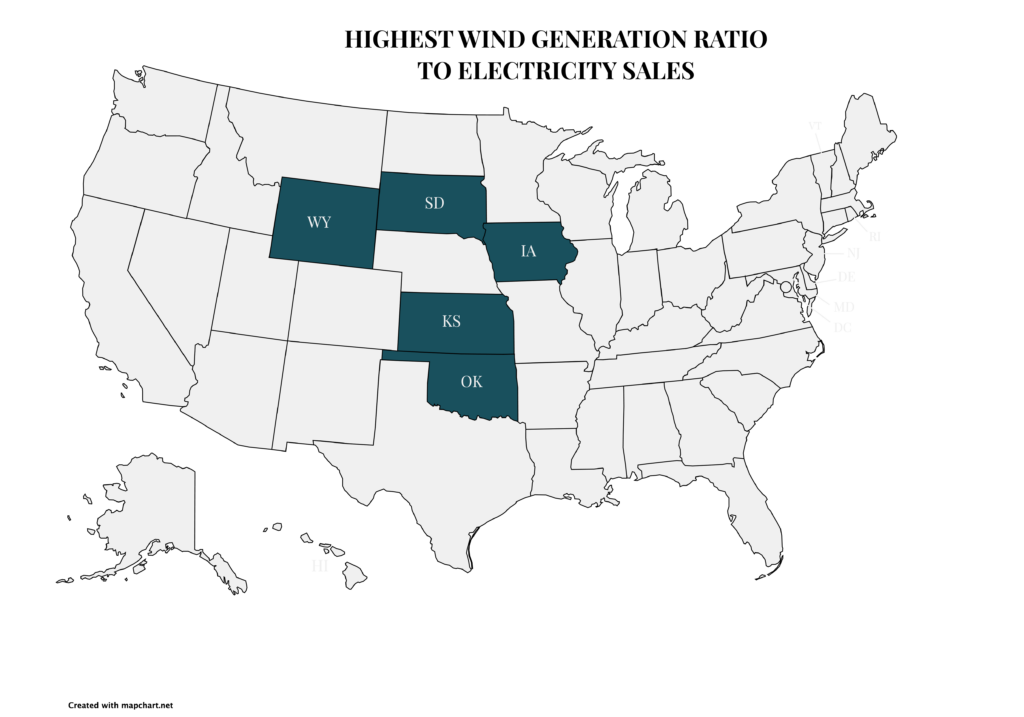Wind and solar power have become leading sources of zero-carbon energy in recent decades, playing a significant role in the U.S. energy grid. While renewable energy initiatives are often linked to Democratic climate policies, Republican-led states have embraced wind and solar energy as strategic investments. These initiatives align with conservative priorities, such as boosting domestic energy production and reducing energy costs. From expansive wind farms in Texas to solar installations in Florida, traditionally “red states” are at the forefront of America’s renewable energy transformation.
Which states are leading
Using Climate Central’s dataset—based on the U.S. Energy Information Administration—we analyzed large-scale wind and solar deployment across the U.S. as of 2023. The maps below highlight the top five states for various deployment metrics:
- Total Installed Wind Capacity
- Total Installed Solar Capacity
- Wind Generation Relative to Retail Sales
- Solar Generation Relative to Retail Sales
These data provide a clear snapshot of where wind and solar energy are most prominent and illustrate how rankings shift when accounting for each state’s total electricity demand.
Across all four maps, there is notable representation from states where Republicans have historically performed well electorally. For instance, wind energy has flourished in Texas, Oklahoma, Iowa, South Dakota, Kansas, and Wyoming. Similarly, large-scale solar has expanded in states like Florida, Georgia, Utah, and North Carolina.
While traditionally Democratic-leaning states like California and Illinois have made substantial investments in large-scale renewable energy, many Republican-dominated states are also leaders in deploying these technologies. Previous analyses at the state and county levels confirm this trend, showing that red states and counties are playing a key role in the expansion of renewable energy projects across the U.S.




Drivers of renewable energy growth
Several factors contribute to the rapid growth of renewable energy in these states, from the geography of natural resources to market structures and energy policy.
1. Resource strength
The availability of natural resources plays a crucial role in the deployment of renewable energy. States in the “wind belt,” stretching through the Great Plains, benefit from optimal conditions for wind power, leading to higher returns on investment. Similarly, the sunny climates of the Southwest and Southeast make these regions ideal for solar energy. This alignment is reflected in the top performing states—Kansas, Iowa, and South Dakota lie in the heart of the windiest parts of the country, while Georgia, Florida, and Arizona are in the“sun belt.”
However, the growth of renewable energy is not limited to states with the most abundant natural resources. Falling technology costs and advances in efficiency are making large-scale wind and solar projects economically viable even in areas once considered less suitable. For example, despite lacking Arizona or Florida’s respective solar densities, Wisconsin ranks 11th nationally in solar farm capacity.
2. Market structures
Access to competitive wholesale markets for electricity has been a significant driver of clean power growth. Many states with abundant wind resources, like Kansas, Oklahoma, and Iowa, benefit from participation in regional grids like the Southwest Power Pool (SPP) and Midcontinent Independent System Operator (MISO). These grids allow renewable energy developers to engage directly in the market, selling power to utilities or corporate buyers like Walmart and Microsoft.
Even states outside of organized competitive markets have found ways to encourage renewable deployment through competitive mechanisms. Under the Public Utility Regulatory Policies Act (PURPA), some states have established limited wholesale markets. For example, North and South Carolina have developed substantial solar capacity under PURPA contracts, which enable renewable energy developers to compete with the monopoly utility provider to meet part of the state’s energy needs.
Additionally, there are regulatory frameworks that support renewable energy development by monopoly utilities themselves. These mechanisms illustrate that renewable energy technologies can thrive under a variety of market structures.
3. Enabling policies
Policy design has been a crucial factor in enabling the expansion of wind and solar energy. State and federal incentives, grid modernization initiatives, and strategic long-term energy planning have all played key roles in this growth.
- State tax incentives: States like Wyoming and Oklahoma implemented state tax incentives to kick-start wind energy development, which were phased out as the industry became self-sustaining.
- Long-term energy planning: Georgia has added multiple gigawatts of solar farms, achieving its national leadership position for that technology, under the state’s long-term energy planning process overseen by the Public Service Commission. Republican Commission Chairman Lauren McDonald highlighted that Georgia’s approach is market-based and added significant renewable capacity without raising rates for consumers or relying on state subsidies.
- Grid modernization: Texas enacted a state law driving high-voltage transmission line construction, infrastructure which enabled extensive buildout of wind farms that have saved consumers money on power.
- State regulatory decisions: In Louisiana, recent policy developments highlight the significant impact of regulatory decisions on clean energy expansion. Situated squarely within the sunbelt and part of the organized competitive market known as MISO, the state has both resource and market advantages for new technology deployment. Still, Louisiana has historically lagged behind less sunny states like Maine and Ohio in solar farm development. However, a pivotal order from the Louisiana Public Service Commission in 2024 approved a new regulatory policy unlocking up to three gigawatts of solar. This initiative positions Louisiana to ascend in national solar energy rankings.
- Enabling federal frameworks: Federal policies such as tax credits have also been essential in making large-scale wind and solar energy an option for states.
Powering ahead
Renewable energy leadership is not confined to traditionally blue states like California. In fact, red states across the country have been major players in the adoption of wind and solar power. Republican-led states have embraced renewable energy for its potential to reduce electricity costs, revitalize local economies, and diversify energy supplies. Leveraging a range of market mechanisms and policy tools, these states have successfully deployed hundreds of large-scale wind and solar projects.
The growth of renewable energy in Republican-led states challenges the perception that clean energy is a partisan issue. From energy security and job creation to decarbonization and competitive energy costs, the appeal of renewable energy spans the political spectrum. Moreover, the variety of approaches employed—from market-driven solutions to targeted policy frameworks—demonstrates the adaptability of wind and solar technologies to diverse economic and regulatory environments. The nationwide expansion of wind and solar farms highlights their pivotal role in building a robust, resilient, and inclusive energy future for all Americans.